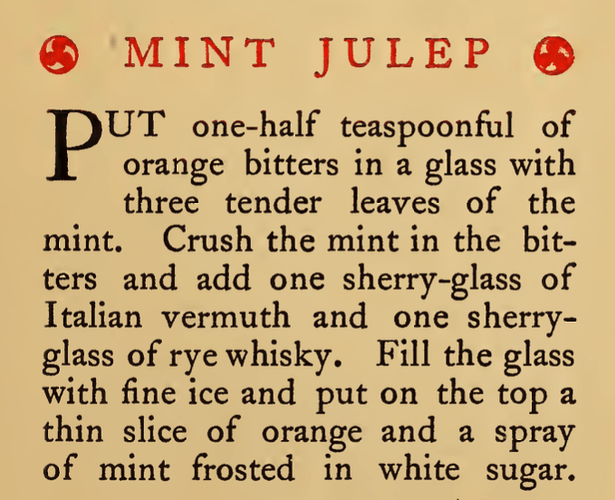Has anyone encountered Mint Julep recipes that call for bitters? It’s kind of surprising, but not unheard of that some whiskey-based cocktails from the golden age do not have bitters in the recipe.
Personally, I have never seen a Mint Julep recipe, regardless of spirit, that calls for bitters. But it’s worth noting that the popularity of Mint Juleps in the US outdoes the population of bittered Slings and Cock-tails. Bitters of course were around, but it also depends on what you define as the “Golden Age”. Late 1800s or mid-1900s to Prohibition?
Yes, I was thinking Jerry Thomas up until Harry Craddock.
Well, looking through my copy of Jerry Thomas’ book there’s no bitters. Same can be said with a quick glance through http://euvslibrary.com/. Although, it looks like Liquor.com and Simon Difford do bitters in their Mint Juleps. But they both call for bourbon. Bourbon was not commonly used in Juleps prior to the early-20th century and rye whiskey only became popular after the phylloxera outbreak put brandy on back order.
The earliest one that I know of is the Rum Julep by Donn the Beachcomber circa 1940. Plenty of examples in 2005-2025 though including the Magic Julep (50:50 split of Fernet and Angostura)
Originally the Julep–booze, sugar, water, mint–and the Cocktail–booze, sugar, water, bitters–were complementary, with the mint and the bitters offering competing solutions to the problem of how to spice up a boring old Sling. Moint-Sling and Bitter-Sling, as they were known.
But you know what happens in America when you try to set up hard and fast distinctions. This:
(From an article on staging the perfect “ladies’ lunch” in the Pittsburgh Dispatch, August, 1891.)
It’s true, as far as I can tell, that in 1891 this was rather outside the mainstream of Julep-making. But again in 1902, I find the Santa Cruz Sentinel pushing orange bitters in a Julep, although the other details are different:
This formula would gain traction seven years later, when the New York Times printed it and others reprinted their reprint. In 1915, the New York Sun went so far as to label it as “a good old Kentucky recipe,” which it almost certainly was not.
There may, however, have been at least a grain of truth in that: in 1934, one of G. Selmer Fougner’s correspondents in the New York Sun wrote that he had grown up “within 100 yards” of Irvin Cobb, the Paducah-born journalist who was one of America’s biggest blowhards on the subject of the Julep. What Fougner’s correspondent wanted to know was why, in his recent booklet on the drink, Cobb “left out the dash of Angostura bitters that most mint julep makers used.”
Which leaves us on Donn Beach’s threshold, always a fine place to be.
Following on from @Splificator above, the orange bitter, vermouth, sherry and rye version also popped up in the 1904 book “One Hundred and One Beverages”:
And again in 1910 as “Mint Julep No. 2” in the lesser known “Light Entertaining” by Helena Judson:
The only slightly more famous reference to bitters in Juleps I have found is that David Embury recommends making the drink with bitters in his now classic The Fine Art of Mixing Drinks where he writes:
In a bar glass place, for each drink, 1 tablespoonful sugar syrup, about a dozen tender young mint leaves, and 2 or 3 good dashes of Angostura. If you don’t like bitters, leave them out, but, in my opinion, they add enormously to the character of the drink.
Although with those few exceptions, the classic Julep seems to be solidly without bitters until we get to more recent times where modern bartenders are mixing up the drink more widely as a loose family by adding in Fernets and Amaros to bitter the drink, such as the Aperitivo Julep by Alex Day from Death & Co.



